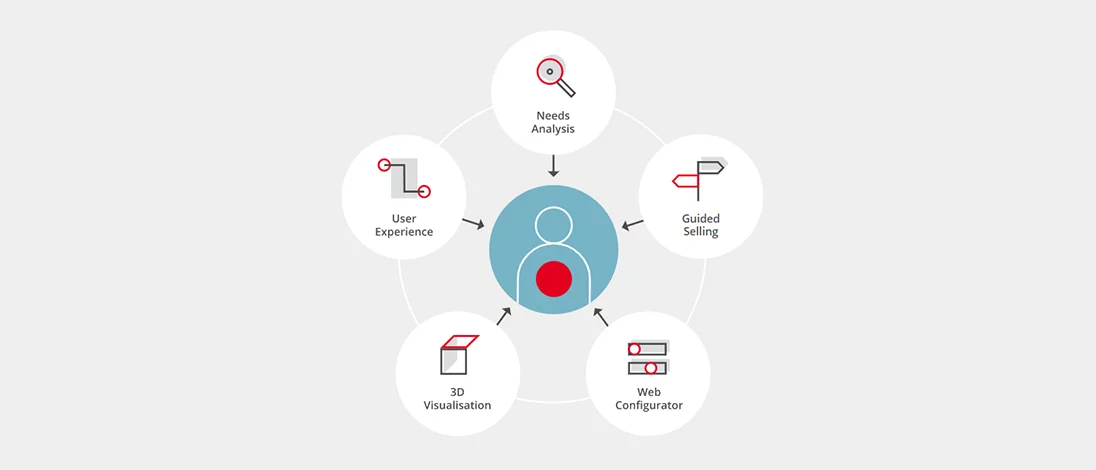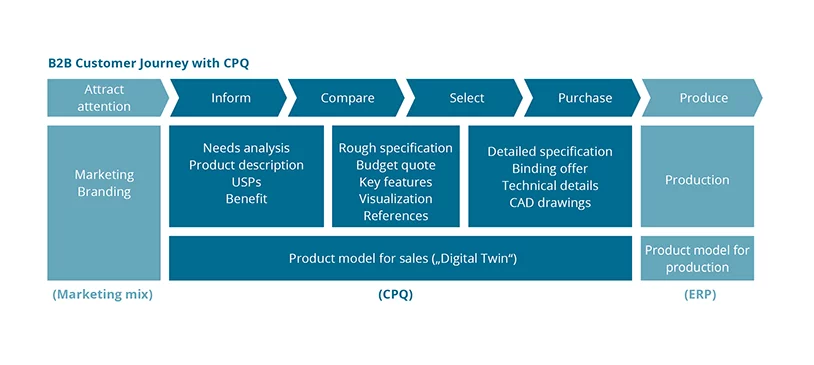360 Degree User Experience in B2B-Sales
It can already be felt in day-to-day business: The sales process in B2B transactions is changing. The current study titled ‘Accelerate Your Journey to Modern Commerce’ by Forrester Research analyses the changes to the point: Online sales will also increase in the B2B sector. Buyers prefer to inform themselves independently about products and solutions.
A change in behaviour in the preparation of investment decisions is taking place, as has long been observed in the B2C sector. Buyers are increasingly using digital channels to procure information. As the scope and complexity of the offered solutions is not decreasing either, companies need to intensify and focus the information about their products on online channels. According to the Forrester study, this is the only way B2B companies will be able to compete. For companies, this means: In the sales process, the right information must be provided to interested parties in an easily accessible and comprehensible manner. And, where possible, in such a way that the buyer can retrieve this information without direct contact with the supplier. This is because market research companies such as Forrester Research estimate that roughly 60 per cent of information procurement today already occurs in the early phase of the sales process.
The information offer alone does not suffice
Yet the pure provision of information is not all that matters. The right amount of information must also be available at the right time. In the past, sales was the body that would accompany customers throughout the entire process. This ensured availability in the right context.
The profound changes in the acquisition of information requires the preparation of content for the respectively suitable context. This method, known as the Customer Journey, structures the information offered based on personas, i.e. the roles involved in the investment decision, and the phases of the investment decision.
Companies must respond to the changing role of sales in B2B transactions by adapting the sales process. The focus shifts onto the Customer Journey as a method for controlling the information supply for the entire process.
Complex product solutions in the B2B field present companies in mechanical and plant engineering, for example, with the challenge of configuring, visualising and offering individual, personalised solutions in the Customer Journey with the expected detail level.
CPQ systems as a strategic tool
Modern CPQ systems (Configure, Price, Quote) create the basis for this. They create a way to provide needs-based product solutions in varying degrees of detail according to the phases of the Customer Journey, from acquiring information to the purchase decision: be it initial product information, budget offers or detailed, binding offers. The individual product configuration is therefore of central importance. The user experience for all target groups involved in the process is decisive for the acceptance of such solutions and thus for their successful implementation. The user experience describes the role-specific, exceedingly positive experience when using the CPQ solution. The emotional aspect also does not play an insignificant part in the B2B environment, in that context. A winning user experience has a positive effect on the purchasing decision and strengthens the competitive position. Thus, a CPQ system is a strategic tool in the sales process that plays a central role in implementing the Customer Journey. It significantly contributes to the overall success with a perfect user experience and a 360-degree view of the individual product configuration.
Sales channels are part of the customer journey
Technology, market segments, internationalisation and historically grown structures require sales organisations that are adapted to the company. Ideally, in a CPQ solution, all sales channels, whether direct sales, dealers or agents, are integrated into the Customer Journey and the user experience for the customer is uniformly high. This guarantees a consistently high quality of the information for the customer.
To create configurations that meet the requirements, uniform product models in all sales channels across the entire Customer Journey are particularly important for the solution’s consistency. The exchange of information across channels, e.g. from the dealer to the manufacturer, is thereby simplified. Yet the detailing of the configured product from a budget offer to the final, detailed offer, for example, is also only made possible this way. The added value for all those involved also lies in avoiding any information losses and error sources.
A sales process that is consistently orientated on the Customer Journey and the use of a CPQ system complement each other perfectly. Companies can strengthen their competitive position this way.
Whitepaper: Future of B2B Sales
In this free whitepaper you will learn:
1. How purchasing behavior for industrial products is changing.
2. What the key challenges for the digitalisation of B2B sales are.
3. How these challenges can be solved with CPQ.
You will be introduced to the fields of action for the digitalisation of B2B sales:
1. Provide relevant information at the right time.
2. Convince emotionally in a digital environment.
3. Ensure a consistent user experience across all channels.
4. Achieve a competitive advantage with short reaction times.

